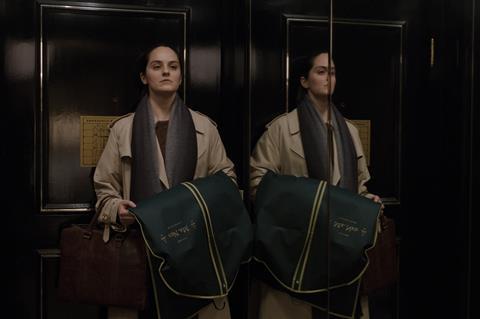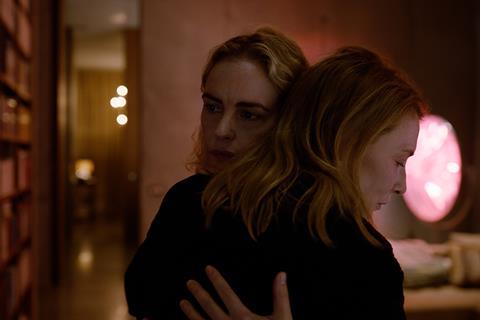The international world of classical music is the unlikely frame to push hot-button identity politics and cancel culture photographed in chilly undertones by Florian Hoffmeister, reports Adrian Pennington
While press attention is focused on Cate Blanchett’s tour de force performance as acclaimed German composer-conductor Lydia Tár in writer-director Todd Field’s Tár, the subtler but still virtuoso camera work of cinematographer Florian Hoffmeister BSC deserves recognition.

The power and self-confidence of the psychodrama’s mesmerizing central character is surgically exposed and deconstructed in intense close-ups and deft single take ‘oners’.
“Reading the screenplay I had the feeling of being in an orchestra amid all the interaction and dynamics of the musicians and with the conductor in the middle of them,” Hoffmeister told IBC365. “It was as if it were written by somebody who had spent half of their life in an orchestra.”
“At the same time, I had this slight feeling of detachment,” he said. “Todd’s script was very precise and really intimate, but also detached and because of that detachment I became aware of the nuances of her character and of the movie’s many layers of reality.”
The film begins with a Q&A between Tár and an interviewer from the New Yorker on stage in front of an audience. The scene which unfolds in real-time sets the superstar composer up for a fall as she monologues about her illustrious career.
Read more The best of behind the scenes
“Todd was adamant that we wanted to put the film’s audience in the room with her,” the DoP said. “When we began to shoot scenes with the orchestra the temptation was to move the camera but Todd didn’t want to. It’s a form of camera placement where the camera just observes and the longer I can observe the more intimate it will feel. To me, that was one of the key experiments; that even though you start from a place of restraint, it is really liberating.”
Behind the Scenes: Tár - ten-minute takes
Later in the first act, we find Tár teaching at Juilliard, the private performing arts school in Manhattan. In a ten-minute long take, Tár prowls around a virtually empty lecture hall demonstrating her power and taking a student to task for not taking Bach’s music seriously as a result of the composer’s misogyny. She also sits down at the piano and plays, condescendingly, to make her point.

“Often very complicated scenes for the actor are simple for the camera,” said Hoffmeister. “Close ups of great emotional value are basically a camera on a set of sticks. In contrast, some very complicated camera moves are often very simple for an actor. They might just have to run but the camera has to follow.
“This sequence was very, very difficult to pull off technically but at the same time it is a masterclass in performance and acting.”
Field and Hoffmeister spent a day exploring how to move the camera and another day rehearsing day with Blanchett. “It is a crucial scene. The writing is very complex, as is the performance. Cate had to play piano for real and to act at the same time. We set out to do it in ‘one’ and we achieved that.”
The film was mostly shot in Dresden with its philharmonic orchestra, and in Berlin with some scenes in South East Asia. Hoffmeister spent time recceing locations with Field to gauge how to translate the director’s vision to screen.
“Lighting Tár to me meant first and foremost authenticity of space. The light should always feel really connected to the space we are depicting and not necessarily as a strong stylised choice. It should never be noticeable. Of course, at the same time you have to shape and guide things and sometimes disguise things but it’s all based on authenticity.”
That philosophy formed the basis of Hoffmeister’s discussions with Field about Lydia Tár’s state of mind. “In lighting I wanted to distinguish between her ‘appearing’ in contrast to her ‘being’. For the character those were two different things.
“So when Tár appears before an audience which could be an audience of thousands or just one for example, when she has dinner with Eliot Kaplan (Mark Strong), we would shape her with more contrast, she would be keyed very strongly, to make her more of a persona. Whereas in her apartment with Sharon (her lover) or in her study in moments of anxiety or of pure creativity we would keep lighting very soft almost in an open shadow. Then those worlds collide in the scene at the end when she is doing her book reading in New York. Even though this is another performance in front of a crowd, the lighting isn’t giving her that uplift anymore and she is very frail.”
Behind the Scenes: Tár - lens choice
In tests, the cinematographer narrowed down his choice of lens, finding that both he and Field loved the look of an older Zeiss glass. They took this look to ARRI in Berlin where optical specialist Christoph Hoffsten got to work to hand-tune a series of ARRI Signature Primes to pair with ARRI Alexa LF and the 65 model.

Collaborating on the film’s steely colour palette of cool blues and neutral tones was colourist Tim Masick who was open to working with an original ARRI developed digital print emulsion.
“ARRI made this digital template years ago to prove basically that the Alexa sensor could look like film. We call it a digital print emulsion in contrast to a LUT which to me is something you cook up in a grading suite in an afternoon. I don’t necessarily miss shooting on celluloid, what I miss is the form of communication you had between a grader and the lab which this print emulsion embodies.”
Hoffmeister had not worked with Field before but said he admired him ever since seeing the director’s debut feature In The Bedroom in 2001.
“Not only did I enjoy it as an audience member it felt seminal and spoke to me very strongly. I never imagined I’d work with him twenty years later.
“He really encourages me to step out of comfortable zone. ‘Don’t gild the lily’ he said. He was very adamant about what he wanted to achieve. I felt my position was to mould the light, to set the tone to meet his intent without the audience being in any way distracted.”
Hoffmeister previously worked with director Terence Davies (The Deep Blue Sea and A Quiet Passion). His other credits include Official Secret, and Johnny English Strikes and British mini-series Great Expectations (for which he won an Emmy and a BAFTA) and AMC’s The Terror. He is currently in Iceland shooting the fourth season of HBO’s True Detective starring Jodie Foster.
























No comments yet